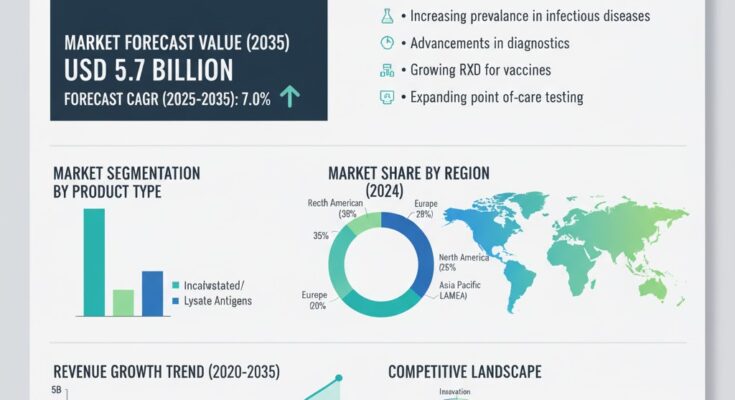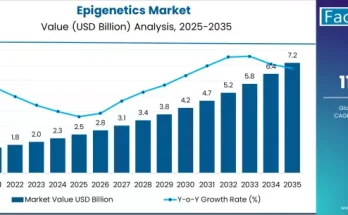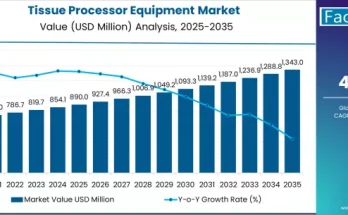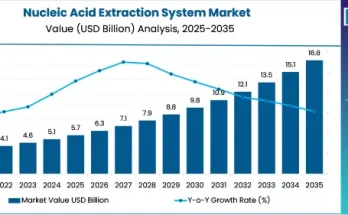The global viral antigens market is witnessing robust expansion driven by increasing infectious disease prevalence, advancements in diagnostic testing, and heightened global health surveillance. Valued at USD 2.9 billion in 2025, the market is projected to reach USD 5.7 billion by 2035, recording an absolute increase of USD 2.8 billion over the forecast period. This reflects a compound annual growth rate (CAGR) of 7.0% between 2025 and 2035, according to a recent report by Fact.MR.
As global healthcare systems prioritize rapid diagnostics and preventive disease management, viral antigens play a pivotal role in enabling early detection and accurate monitoring of infections such as influenza, hepatitis, HIV, and SARS-CoV-2. Continuous investments in R&D and biomanufacturing are fostering innovation in antigen production, purification, and assay design.
Market Drivers: Diagnostic Expansion, Vaccine Development, and Global Surveillance
- Growing Burden of Infectious Diseases
The increasing incidence of viral infections across emerging and developed regions is driving the need for reliable antigen-based diagnostics. Early detection remains critical in outbreak containment, and viral antigens form the cornerstone of several diagnostic assays, including ELISA, lateral flow, and immunofluorescence tests.
- Technological Innovations in Antigen Production
Recombinant DNA technologies and advanced expression systems are transforming viral antigen synthesis, improving accuracy, reproducibility, and yield. Companies are adopting mammalian, insect, and bacterial expression platforms to achieve high-purity antigens that enhance test performance and reduce production costs.
- Expanding Applications in Vaccinology and Therapeutics
Beyond diagnostics, viral antigens are increasingly used in vaccine development, serological testing, and therapeutic monitoring. The integration of antigens in next-generation vaccine platforms—such as subunit and mRNA vaccines—is boosting their strategic importance in global health initiatives.
- Strengthened Public Health Infrastructure
Global investments in infectious disease surveillance, including pandemic preparedness initiatives and centralized laboratory networks, are increasing the procurement and standardization of viral antigens across testing protocols. This is particularly evident in North America, Europe, and parts of Asia-Pacific.
Competitive Landscape
The viral antigens market is moderately consolidated, with leading players focusing on innovation, global distribution, and quality compliance. Strategic partnerships, product launches, and acquisitions are central to maintaining competitiveness in this evolving domain.
Key Players in the Viral Antigens Market:
- Merck KGaA
- Creative Diagnostics
- ProSpec-Tany Technogene Ltd.
- The Native Antigen Company Ltd.
- Sino Biological Inc.
- Vircell S.L.
- BioVision, Inc.
- Thermo Fisher Scientific Inc.
- RayBiotech Inc.
- ZeptoMetrix Corporation
These companies are leveraging high-throughput antigen manufacturing, enhancing diagnostic assay compatibility, and expanding their portfolios to cover a broader spectrum of viral pathogens.
Recent Developments
- August 2025 – Thermo Fisher Scientific announced the expansion of its viral antigen portfolio for next-generation diagnostic kits targeting respiratory viruses.
- June 2024 – Sino Biological launched a new range of recombinant viral antigens for emerging pathogens, supporting vaccine R&D and neutralization studies.
Regional Insights
- North America – Dominates the market due to advanced healthcare infrastructure, established diagnostics industry, and robust R&D funding.
- Europe – Strong regulatory frameworks and increased infectious disease testing are fueling steady growth, particularly in Germany and the U.K.
- Asia-Pacific – Exhibiting the fastest growth, driven by high population density, emerging infectious diseases, and increasing healthcare investments in China and India.
Future Outlook: Toward Advanced and Multiplex Diagnostic Platforms
The next decade will see viral antigen technologies evolve toward:
- Multiplex Detection Systems – Simultaneous detection of multiple pathogens from a single sample.
- AI-Integrated Diagnostics – Data-driven analysis for real-time disease tracking and early warning systems.
- Customizable Antigen Libraries – Tailored solutions for emerging and rare viruses.
- Sustainable Manufacturing Practices – Use of recombinant and cell-free synthesis methods to reduce biohazard waste.
By 2035, the viral antigens market is expected to be a cornerstone of precision diagnostics and preventive medicine, enhancing the global capacity to detect, monitor, and combat infectious diseases efficiently.



